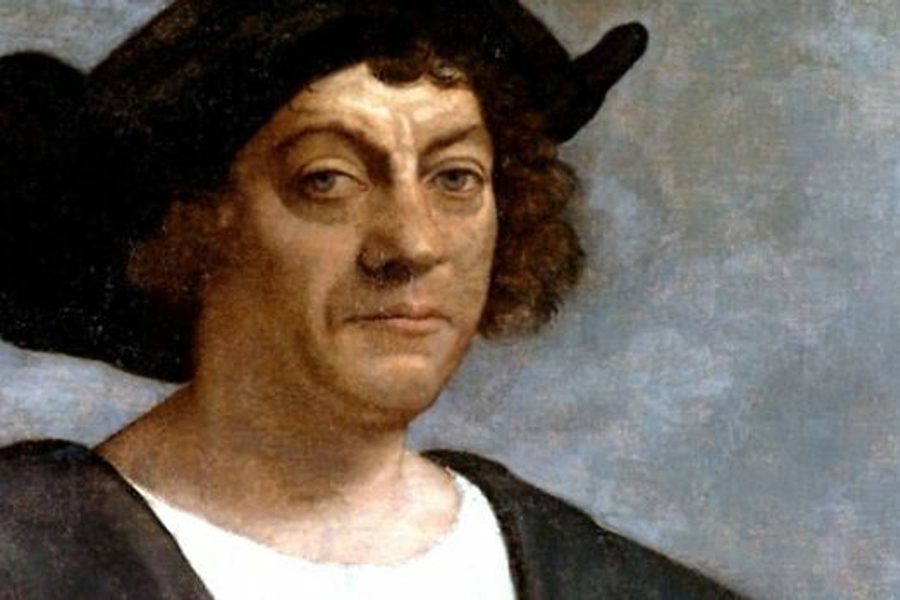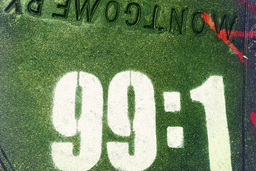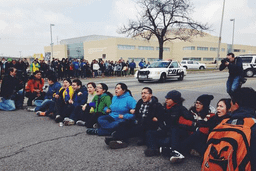
On the morning of October 12, 1992, a triad of other-worldly ships crossed the sludgy water of the San Francisco Bay – invaders headed for shore. But the ship couldn’t (or wouldn’t) land for the 4,000 area natives lining the docks.
On the quincentennial of Christopher Columbus’ maiden voyage to the “New World,” San Francisco’s North Beach-based Italian community had dreamed up an especially extravagant celebration. The city planned to reenact the Italian’s landing in the Carribean by navigating faux Spanish ships into the narrow alleys of the Bay and “discovering” the Western Hemisphere anew. But this time, the voyage of the Niña, Pinta and Santa Maria 2.0 encountered an unexpected storm: One of the first large-scale anti-Columbus Day actions in the US.
Members of the American Indian Movement were joined by groups such as the Anarchist-Communist Coalition, the General Union of Palestinian Students, Queers for Cuba and others who opposed the explorer’s legacy. Though 40 were arrested, the blockaders succeeded in effectively stopping Columbus’ second coming. That year, the city of Berkeley also rechristened Columbus Day as “Indigenous Peoples Day,” and demonstrations were planned across the country under the auspices of the “Resistance 500” network.
But five hundred and twenty years after Columbus first “sailed the ocean blue,” the U.S. is still celebrating the harbinger of colonialism, slavery and globalization with a federal holiday. The man’s crimes are so well-known, they’re hardly worth recounting. After over 500 years of indigenous resistance to the colonial project, a wide array of U.S. activists have joined the fight to abolish Columbus and his legacy.
Saturday, a different set of San Francisco activists marched through the city’s downtown to challenge the collective memory of Columbus in a “Fuck Columbus Day” march against colonialism and capitalism. A tussle with police landed 22 protestors in cuffs by day’s end, but the incident is just one of many anti-Columbus actions that took place over the long weekend.
In Denver, where annual Columbus Day parades have in the past seen large-scale counter-demonstrations and arrests, Occupy Denver supported a call from the American Indian Movement to protest the Sons of Italy demonstration today.
Students at Fort Lewis College in Durango, Colorado are countering Columbus with a “Real History of the Americas” day. Noel Genevieve Altaha, an event organizer and member of the White Mountain Apache Tribe, told Democracy Now’s Amy Goodman the day’s importance is all about remembrance and respect. “…My job is just to be the vessel that allows others, those peoples that were — their stories were hidden and erased and silenced on this one day, to share and embrace that.”
The Twitterverse was rife with the “fuckcolumbus” hash tag and calls for a national Indigenous Peoples Day all holiday weekend. One user wrote, “I found an already established country. [Where’s] my holiday? #fuckcolumbus.” A popular Columbus Day meme has been making the rounds again this year (It features of portrait of Columbus with a caption that reads “I discovered America.” The next frame features a group of Native Americans huddled around an open book that says “LOL repost.”) A 2010 “Reconsider Columbus Day” campaign video is also trending.
The outpouring of anti-Columbus Day posts on social media outlets signifies a shift in public opinion over a holiday that has already been abolished or reimagined in Santa Cruz, Calif.; Columbus, Ohio and the state of South Dakota, which celebrates Native American Day.
But the holiday’s history is deep-rooted. The Society of Saint Tammany (also known as the Columbian Order), celebrated Columbus’s landing in 1792, but the first official observation of the newly-minted holiday wasn’t until its 400 anniversary in 1892. President Benjamin Harrison issued a statement “recommending to the people the observance in all their localities of the 400th anniversary of the discovery of America…” Harrison went on to call Columbus “the pioneer of progress and enlightenment.” The 1893 World’s Fair in Chicago (or the World’s Columbian Exposition) became a part of the anniversary festivities.
Knights of Columbus groups took spent the early 1900s lobbying state legislatures to recognize October 12 as a Columbus Day and by the end of World War II, it was a national holiday.
“I can never think of Hispaniola without tears,” Columbus wrote in a ship log during his last voyage across the Atlantic to Spain in 1504. Columbus the storied explorer went on to die nearly penniless and stripped of his royal titles (for cruelty to the indigenous and his own crew) in Valladolid, Spain. For indigenous people, there is much more to mourn.
As editor and publisher of The South Shore Standard wrote on his Huffington Post blog yesterday:
So, while Columbus’ legacy has been good for white Europeans and their progeny, it set in motion no end of ethnic cleansing, genocide, dispossession, disease and despair for Native Americans (both in North and South America) that to a great extent prevails to this day, notwithstanding the ubiquity of Indian gambling casinos. It also set the stage for the forceful importation of millions of blacks from Africa, their being dragged into slavery and their legacy of persecution and discrimination.

I hope you found this article important. Before you leave, I want to ask you to consider supporting our work with a donation. In These Times needs readers like you to help sustain our mission. We don’t depend on—or want—corporate advertising or deep-pocketed billionaires to fund our journalism. We’re supported by you, the reader, so we can focus on covering the issues that matter most to the progressive movement without fear or compromise.
Our work isn’t hidden behind a paywall because of people like you who support our journalism. We want to keep it that way. If you value the work we do and the movements we cover, please consider donating to In These Times.



